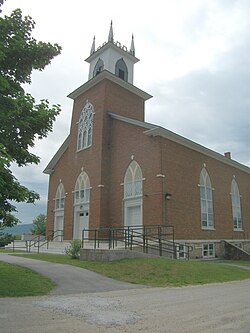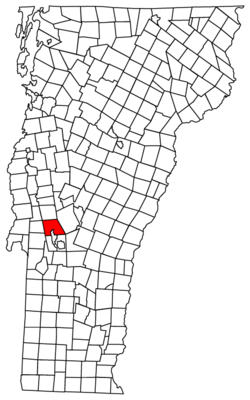History
Pittsford was first settled as a frontier town in 1769, about 60 miles (97 km) north of Bennington. It is the location of two historical picket forts used by the militia during the American Revolutionary War: Fort Mott (built in 1777), and Fort Vengeance (built from 1780 to 1781), about a mile north.
The town of Pittsford, New York, was named by Colonel Caleb Hopkins after his hometown of Pittsford, Vermont, named after William Pitt. [4]
The first settlers and founders of Pittsford were the Cooley half-brothers, Benjamin Cooley (b. 1747, d. 1790) and Gideon Cooley (b. 1731, d. abt 1800). [5] Benjamin Cooley joined Ethan Allen, Benedict Arnold, and the rest of the Green Mountain Boys in the first victory of the Colonies over England: the Capture of Fort Ticonderoga on 10 May 1775. [6]
Demographics
Historical population| Census | Pop. | Note | %± |
|---|
| 1790 | 850 | | — |
|---|
| 1800 | 1,413 | | 66.2% |
|---|
| 1810 | 1,936 | | 37.0% |
|---|
| 1820 | 1,916 | | −1.0% |
|---|
| 1830 | 2,005 | | 4.6% |
|---|
| 1840 | 1,927 | | −3.9% |
|---|
| 1850 | 2,026 | | 5.1% |
|---|
| 1860 | 1,839 | | −9.2% |
|---|
| 1870 | 2,127 | | 15.7% |
|---|
| 1880 | 1,982 | | −6.8% |
|---|
| 1890 | 1,775 | | −10.4% |
|---|
| 1900 | 1,866 | | 5.1% |
|---|
| 1910 | 2,479 | | 32.9% |
|---|
| 1920 | 2,098 | | −15.4% |
|---|
| 1930 | 2,332 | | 11.2% |
|---|
| 1940 | 2,093 | | −10.2% |
|---|
| 1950 | 2,076 | | −0.8% |
|---|
| 1960 | 2,225 | | 7.2% |
|---|
| 1970 | 2,306 | | 3.6% |
|---|
| 1980 | 2,590 | | 12.3% |
|---|
| 1990 | 2,919 | | 12.7% |
|---|
| 2000 | 3,140 | | 7.6% |
|---|
| 2010 | 2,991 | | −4.7% |
|---|
| 2020 | 2,862 | | −4.3% |
|---|
|
As of the census [1] of 2000, there were 3,140 people, 1,284 households, and 876 families residing in the town. The population density was 72.2 people per square mile (27.9/km2). There were 1,388 housing units at an average density of 31.9 per square mile (12.3/km2). The racial makeup of the town was 99.08% White, 0.22% African American, 0.06% Native American, 0.19% Asian, and 0.45% from two or more races. Hispanic or Latino of any race were 0.41% of the population.
There were 1,284 households, out of which 29.7% had children under the age of 18 living with them, 56.2% were married couples living together, 8.3% had a female householder with no husband present, and 31.7% were non-families. 23.8% of all households were made up of individuals, and 9.3% had someone living alone who was 65 years of age or older. The average household size was 2.44 and the average family size was 2.88.
In the town, the population was spread out, with 23.2% under the age of 18, 6.1% from 18 to 24, 30.0% from 25 to 44, 27.6% from 45 to 64, and 13.2% who were 65 years of age or older. The median age was 40 years. For every 100 females, there were 99.9 males. For every 100 females age 18 and over, there were 93.7 males.
The median income for a household in the town was $40,027, and the median income for a family was $44,079. Males had a median income of $34,769 versus $24,342 for females. The per capita income for the town was $19,271. About 6.0% of families and 9.0% of the population were below the poverty line, including 9.4% of those under age 18 and 5.6% of those age 65 or over.
This page is based on this
Wikipedia article Text is available under the
CC BY-SA 4.0 license; additional terms may apply.
Images, videos and audio are available under their respective licenses.



